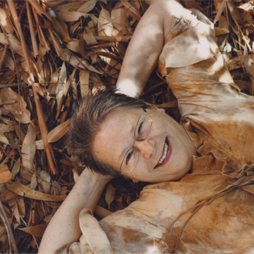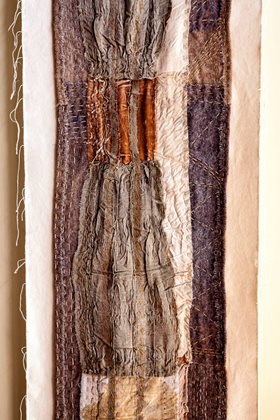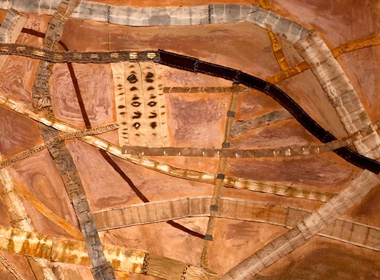 Out there treading lightly: Trudi Pollard’s
Out there treading lightly: Trudi Pollard’s
art practice
Trudi Pollard by Gail Russell
Surrounded by bushland with an outlook onto Wungong Dam, Trudi Pollard’s home studio in Bedfordale offers an immediate insight into what drives a sustained ceramic and textile practice that has spanned three decades.
Vats of liquid dye, the products of time spent collecting eucalyptus leaves and other bush treasures, brew in the sun alongside a cultivated ‘colour garden’ of indigo and other natural dye yielding plants. “It’s all out there,” Trudi says, pointing to the bushland. She has made it her business to learn how to harness what is ‘out there’ by tapping into materials from the environments that she traverses while accumulating a wealth of knowledge on traditional techniques for natural dying from across the globe - Australia, Japan, Cambodia, Indonesia and France.
 The lengthy processes involved in collecting and preparing the materials for Trudi’s ‘stitch paintings’ and other works require a Buddhist-like attitude to time and the moments of pleasure that small things can yield.
The lengthy processes involved in collecting and preparing the materials for Trudi’s ‘stitch paintings’ and other works require a Buddhist-like attitude to time and the moments of pleasure that small things can yield.
This approach has emerged from a childhood spent in Indonesia where Trudi encountered a cross-pollination of philosophical beliefs, together with the experience of being interned in a Japanese war camp for three years during her early childhood. Here, the habit of collecting twigs, leaves, stones and other earthy treasures provided refuge from the turbulent external world.
Trudi recalls how a Japanese officer, impressed by the bravery she had displayed in trying to protect her mother from public punishment, instructed her mother to make her a large pair of bloomers with many internal pockets. Trudi and her pockets acted as a conduit for smuggling food from the Japanese officer to the internment camp. When not used for this purpose, the pockets became vessels for Trudi’s collections, her own private art gallery and the foundation of things to come.
In a work that is silk dyed and steamed with two layers, first indigo and then eucalyptus, Trudi has emulated the form of the Japanese noren, a two panelled hanging used at the entrance or exit between rooms. Metaphorically, the noren represents a room-divider of the mind. People crossing the threshold of these spaces are expected to separate from their memory clutter, to engage with the present.
The significance of the noren translates into Trudi’s working processes, including the stitch in her layered textile road-map paintings. She is emphatic that “it is not about finishing” and she does not mind if some works are never completed. Trudi may stitch to emphasise particular areas that have emerged through the dying and steaming processes or her stitches may allude to the repetitive movement of Trudi’s road trips across Western Australia.
 The road-map ‘stitch paintings’ are a patchwork of impressions, again arising from an intense engagement with what the environment has yielded on route.
The road-map ‘stitch paintings’ are a patchwork of impressions, again arising from an intense engagement with what the environment has yielded on route.
The fabric painting supports have also often been gathered along the way and can incorporate found objects such as the rusty nails in her Kalgoorlie road piece, Findings and marks in sandy bush. Wine Country from Caves Road in the Margaret River region is composed of cotton appropriately boiled in grapes, while Dingo flat road (pictured above) from Denmark bears the marks of being buried under the road for a period of time. Trudi hopes that the “feeling of these processes” transfers to the viewing experience of her work.
Art practice drives Trudi’s life and she embodies Einstein’s assertion that ‘creativity is intelligence having fun’. Just as she continues to harness what is ‘out there’, she will continue to share her accumulated knowledge through teaching workshops, avenues of debate and participation in community related projects as part of a cyclic process of exchange.
Gail Russell is a visual art lecturer at Central Institute of Technology, consultant editor, art writer and research assistant.
To view more of Trudi's work and read about her practice and career, see her page in the Artsource Gallery.